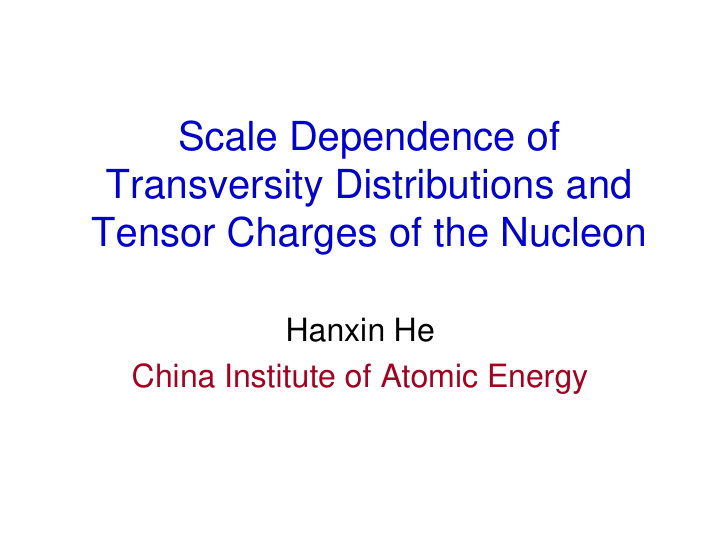



Scale Dependence of Transversity Distributions and Tensor Charges of the Nucleon Hanxin He China Institute of Atomic Energy
Contents 1. Quark distribution functions at leading twist and their first moments--- nucleon’s charges *Helicity distributions and axial charges *Transversity distributions and tensor charges 2. Helicity distributions, axial charges and quark spin comtribution to nucleon’s spin 3. Transversity distributions and tensor charges * Theory estimates of tensor charges * Scale dependence: Perturbative evolutions * Scale dependence: Non-perturbative calculations
1.Quark distribution functions and their first moments Longitudinally polarized Transversely polarized
Quark distribution functions at leading twist Where q_f(x) ---find a quark parton probability in a nucleon
Quark distribution functions at leading twist The transversity distributions measure the difference of number of quarks(antiquarks) with transverse polarization parallel and antiparallel to the nucleon likewise polarized
Helicity distributions and axial charges ( Flavor singlet ) =1.2601 =0.588 Where flavour singlet axial charge gives the quark spin contribution to nucleon’s spin
Transversity distributions and tensor charges The flavor singlet tensor charge and isovector tensor charge can be defined
2.Axial Charges and Quark Spin Contribution to Nucleon Spin • Nucleon spin sum rules All components are scale-dependent
* Nucleon spin sum rules -- satisfying angular momentum commutation relation
Perturbative Evolutions of QCD angular momentum operators
Quark spin contribution to nucleon spin
Quark spin contribution to nucleon spin
Quark spin contribution to nucleon spin The measurement results are given at Q^2 =5 Gev^2
3. Transversity Distributions and Tensor Charges The first moment of transversity distribution gives the tensor charge
Theory estimates of tensor charges — model calculation results
Theoretical Estimates of Tensor Charges • QCD sun rules • Lattice QCD
Tensor Charges in Effective Theory
Scale dependence of tensor Charge: • QCD perturbative evolutions Note that gluons do not enter the evolution equation for transversity distributions due to the chiral-odd property. The evolution equation of tensor charge at leading order
* Perturbutive evolutions of tensor charges to next leading order(NLO )
Perturbative evolution (to NLO)of flavor singlet tensor charge
* Effective theory analyses QCD at low-energy is equivalent to an effective quark theory
Axial charges and tensor charges in the effective theory where
Axial charges and tensor charges in the effective theory Where m is dynamical mass
Dynamically generated quark mass QCD at low-energy scale is spontaneously chiral symmetry breaking, where quarks get dynamical mass
Dynamically generated quark mass
Axial charges of the proton and current quark spin contribution to proton spin The current quark spin contribution is Which is exactly agreement with HERMES’s result.
Quark spin contribution to nucleon spin --- its scale evolution
* Nonperturbative calculations: Effective theory analyses of tensor charges • Flavor singlet tensor charge of current quark contributions (in the asymptotic limit)
Flavor singlet axial charge Flavor singlet tensor charge Isovector tensor charge Where m is dynamic mass of quark in the chiral limit
Scale evolutions of tensor charge Green line is given by effective theory, red line is given by AP equation of perturbative QCD.
Flavor singlet tensor charge(green line) and axial charge(red line) with scale change
Conclusion(1) • Tensor charges are strongly scale dependent quantities. • In the asymptotic limit, tensor charges are For proton For neutron
Conclusion(2) • Quark spin contribution to the nucleon spin is strongly scale dependent • Difference between tensor charge and axial charge shows relativistic effects of quark motion in a nucleon In asymptotic limit Non-relativistic limit
Scale dependence of flavor singlet tensor charge(green line) and axial charge(red line)
Measurements of transversity distributions and tensor charges • HERMES, COMPASS and BELLE Collaborations based on the combined global analysis of measured azimuthal asymmetries insemi-inclusive DIS(SIDIS) and those in processes The results are(central values) ( From Phys.Rev.D75,054032(2007; arXiv:0809.3743 )
Measurements of transversity distributions and tensor charges • Jlab measured the single target spin asymmetry(SSA) in SIDIS
Recommend
More recommend